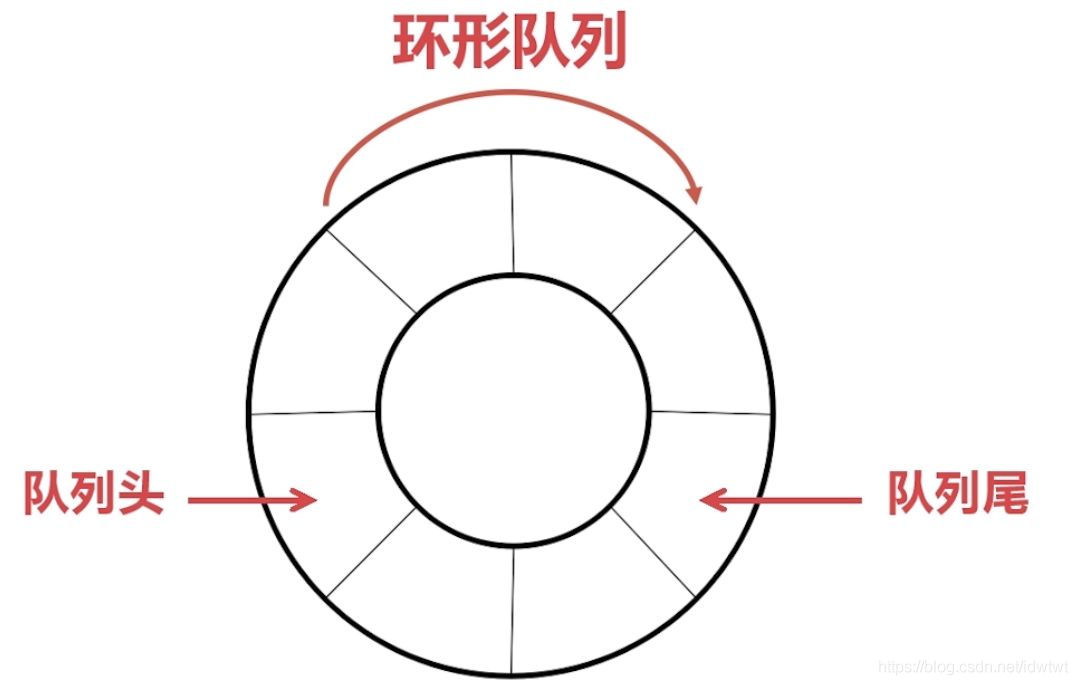chan环形队列 先进先出
[toc]
😶🌫️go语言官方编程指南:https://golang.org/#
go语言的官方文档学习笔记很全,推荐去官网学习
😶🌫️我的学习笔记:github: https://github.com/3293172751/golang-rearn
区块链技术(也称之为分布式账本技术),是一种互联网数据库技术,其特点是去中心化,公开透明,让每一个人均可参与的数据库记录
❤️💕💕关于区块链技术,可以关注我,共同学习更多的区块链技术。博客http://nsddd.top
1.1 环形缓冲区结构
环形缓冲区通常有一个读指针和一个写指针。读指针指向环形缓冲区中可读的数据,写指针指向环形缓冲区中可写的缓冲区。通过移动读指针和写指针就可以实现缓冲区的数据读取和写入。在通常情况下,环形缓冲区的读用户仅仅会影响读指针,而写用户仅仅会影响写指针。如果仅仅有一个读用户和一个写用户,那么不需要添加互斥保护机制就可以保证数据的正确性。如果有多个读写用户访问环形缓冲区,那么必须添加互斥保护机制来确保多个用户互斥访问环形缓冲区。
1.2 环形缓冲区一种读写实现机制
一般的,圆形缓冲区需要4个指针
在内存中实际开始位置;
在内存中实际结束位置,也可以用缓冲区长度代替;
存储在缓冲区中的有效数据的开始位置(读指针);
存储在缓冲区中的有效数据的结尾位置(写指针)。
缓冲区是满、或是空,都有可能出现读指针与写指针指向同一位置:
缓冲区中总是有一个存储单元保持未使用状态。缓冲区最多存入(size-1)个数据。如果读写指针指向同一位置,则缓冲区为空。如果写指针位于读指针的相邻后一个位置,则缓冲区为满。

2 chan内部数据结构
2.1 chan的数据结构
chan实质是个环形缓冲区,外加一个接受者协程队列和一个发送者协程队列
buf :环形缓冲区
sendx :用于记录buf这个循环链表中的发送的index
recvx :用于记录buf这个循环链表中接收的index
recvq :接受者协程队列
sendq :发送者协程队列
lock :互斥锁
2.2 有缓冲区和无缓冲区chan的区别
2.2.1 无缓冲chan数据同步过程和sudog结构
创建一个发送者列表和接收者列表都为空的 channel。 第一个协程向 channel 发送变量的值 channel 从池中获取一个sudog结构体变量,用于表示发送者。sudog 结构体会保持对发送者所在协程的引用,以及发送变量的引用。 发送者加入sendq队列。 发送者协程进入等待状态。 第二个协程将从 channel 中读取一个消息 channel 将sendq列表中等待状态的发送者出队列。 chanel 使用memmove函数将发送者要发送的值进行拷贝,包装入sudog结构体,再传递给 channel 接收者的接收变量。 在第五步中被挂起的第一个协程将恢复运行并释放第三步中获取的sudog结构体。
2.2.1 有缓冲chan
有缓冲chan实质是使用了完整的环形缓冲区,只要缓冲区有空闲,则发送者无需进入等待队列,直接将数据放入环形缓冲区中,如果缓冲区有数据,接受者无需进入等待队列,直接从环形缓冲区中获取数据。
3 关键源码分析
3.1 chan数据结构源码
type hchan struct {
qcount uint // total data in the queue
dataqsiz uint // size of the circular queue
buf unsafe.Pointer // points to an array of dataqsiz elements
elemsize uint16
closed uint32
elemtype *_type // element type
sendx uint // send index
recvx uint // receive index
recvq waitq // list of recv waiters
sendq waitq // list of send waiters
// lock protects all fields in hchan, as well as several
// fields in sudogs blocked on this channel.
//
// Do not change another G's status while holding this lock
// (in particular, do not ready a G), as this can deadlock
// with stack shrinking.
lock mutex
}
3.2 sudog数据结构源码
// sudog represents a g in a wait list, such as for sending/receiving
// on a channel.
//
// sudog is necessary because the g ↔ synchronization object relation
// is many-to-many. A g can be on many wait lists, so there may be
// many sudogs for one g; and many gs may be waiting on the same
// synchronization object, so there may be many sudogs for one object.
//
// sudogs are allocated from a special pool. Use acquireSudog and
// releaseSudog to allocate and free them.
type sudog struct {
// The following fields are protected by the hchan.lock of the
// channel this sudog is blocking on. shrinkstack depends on
// this for sudogs involved in channel ops.
g *g
// isSelect indicates g is participating in a select, so
// g.selectDone must be CAS'd to win the wake-up race.
isSelect bool
next *sudog
prev *sudog
elem unsafe.Pointer // data element (may point to stack)
// The following fields are never accessed concurrently.
// For channels, waitlink is only accessed by g.
// For semaphores, all fields (including the ones above)
// are only accessed when holding a semaRoot lock.
acquiretime int64
releasetime int64
ticket uint32
parent *sudog // semaRoot binary tree
waitlink *sudog // g.waiting list or semaRoot
waittail *sudog // semaRoot
c *hchan // channel
}
3.3 chan的构造过程
func makechan(t *chantype, size int) *hchan {
elem := t.elem
// compiler checks this but be safe.
if elem.size >= 1<<16 {
throw("makechan: invalid channel element type")
}
if hchanSize%maxAlign != 0 || elem.align > maxAlign {
throw("makechan: bad alignment")
}
mem, overflow := math.MulUintptr(elem.size, uintptr(size))
if overflow || mem > maxAlloc-hchanSize || size < 0 {
panic(plainError("makechan: size out of range"))
}
// Hchan does not contain pointers interesting for GC when elements stored in buf do not contain pointers.
// buf points into the same allocation, elemtype is persistent.
// SudoG's are referenced from their owning thread so they can't be collected.
// TODO(dvyukov,rlh): Rethink when collector can move allocated objects.
var c *hchan
switch {
case mem == 0:
// Queue or element size is zero.
c = (*hchan)(mallocgc(hchanSize, nil, true))
// Race detector uses this location for synchronization.
c.buf = c.raceaddr()
case elem.ptrdata == 0:
// Elements do not contain pointers.
// Allocate hchan and buf in one call.
c = (*hchan)(mallocgc(hchanSize+mem, nil, true))
c.buf = add(unsafe.Pointer(c), hchanSize)
default:
// Elements contain pointers.
c = new(hchan)
c.buf = mallocgc(mem, elem, true)
}
c.elemsize = uint16(elem.size)
c.elemtype = elem
c.dataqsiz = uint(size)
if debugChan {
print("makechan: chan=", c, "; elemsize=", elem.size, "; dataqsiz=", size, "\n")
}
return c
}
可以看到,如果不传入size或size=0,则没有为环形缓冲区分配内存,职位chan结构分配内存
3.4 无缓冲收发
// Sends and receives on unbuffered or empty-buffered channels are the
// only operations where one running goroutine writes to the stack of
// another running goroutine. The GC assumes that stack writes only
// happen when the goroutine is running and are only done by that
// goroutine. Using a write barrier is sufficient to make up for
// violating that assumption, but the write barrier has to work.
// typedmemmove will call bulkBarrierPreWrite, but the target bytes
// are not in the heap, so that will not help. We arrange to call
// memmove and typeBitsBulkBarrier instead.
func sendDirect(t *_type, sg *sudog, src unsafe.Pointer) {
// src is on our stack, dst is a slot on another stack.
// Once we read sg.elem out of sg, it will no longer
// be updated if the destination's stack gets copied (shrunk).
// So make sure that no preemption points can happen between read & use.
dst := sg.elem
typeBitsBulkBarrier(t, uintptr(dst), uintptr(src), t.size)
// No need for cgo write barrier checks because dst is always
// Go memory.
memmove(dst, src, t.size)
}
func recvDirect(t *_type, sg *sudog, dst unsafe.Pointer) {
// dst is on our stack or the heap, src is on another stack.
// The channel is locked, so src will not move during this
// operation.
src := sg.elem
typeBitsBulkBarrier(t, uintptr(dst), uintptr(src), t.size)
memmove(dst, src, t.size)
}